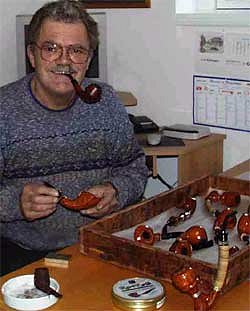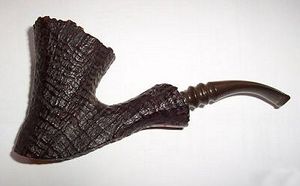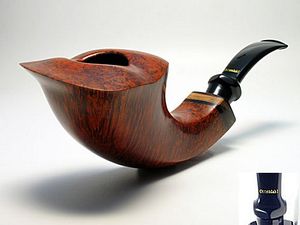Karl Erik
Under construction!
Karl Erik Ottendahl (1942 - 2004)
He was born in Aalborg (Jutland) in 1942, just a few miles from the very northernmost tip of Denmark. He began his career as a Lithographer as an apprentice in the craft at the age of 16. While working as an apprentice he began hand carving pipes as a hobby and to give as gifts to his more senior colleagues.
Upon completion of his apprenticeship he moved to Nairobi, Kenya to work as a lithographer during the 1962 war. While in that war torn country, he was unable to procure pipes for himself. In the face of such a predicament, he chose to continue to make pipes for his own use rather than go without. He returned to Denmark after three years and began making a few pipes on the side to boost his income. His reputation grew and he was finally able to purchase machinery and begin working full time as a pipe maker.
He began his career making pipes for various labels in Denmark and the United States. Often he would make the higher grade pipes for a well known brand that was known for their midrange or low end pieces such as Wally Frank or (less well known in the U.S.) Europa. While doing this he administered a factory of fifteen craftsmen.
Brands produced by Karl Erik Ottendahl:
- Champ of Denmark
- Jobey Dansk (For Weber Pipe Co. in Jersey City, NJ. The pipes were illustrated in the cataloges of The Tinderbox from 1970's - 80's.) ¹
- Knute
- Larsen & Stigart (Once a famous Copenhagen pipe shop, now almost forgotten. They even managed to supply Dunhill with wild danish fancy pipes.)
- Shelburne
- Sven Egholm
- Wenhall
Ottendahl discontinued all exports to the United States in 1987 due to waning sales and attempts of his business partners to screw down prices.
During this period he did make of some of his own handmade pipes, but he felt that the responsibility of managing the factory did not give him the freedom he wished he had. Accordingly, in 1990, he went back to working on his own. He believed that he could produce better work if he worked alone, though his principle reason was simply that he missed the quiet,pleasant atmosphere that a one man shop afforded him. According to Mr. Ottendahl, he has been much happier since he returned to making all of the pipes himself. Certainly, the results reflect his rediscovered happiness with the pipe making craft.
Though Karl Erik's briar mostly comes from Morocco or Greece, he frequently purchases elsewhere too. He doesn't consider the briar origin to be particularly important provided the briar is well cured. Therefore, he simply purchases the best briar he can find, rather than purchase from only one or two regions.
Karl Erik's style emphasizes the wood over all other contributing factors by allowing the grain to determine the ultimate shape of the piece. He further emphasizes the natural, organic, flowing shape of his bowls with hand cut stems and a variety of different bands. These superb pieces of remarkable quality are, almost certainly, the least expensive high-quality hand made pipes coming from Denmark today.
Around 1998/99 he traded the German rights to his brand name "Karl Erik" to Planta, better known as the proprietor of Design Berlin (db). Thus - though db copied the style of the old Karl Eriks pretty closely - a recent KE offered for sale in Germany is unfortunately about as Danish as Eisbein mit Sauerkraut.
While everywhere else a Karl Erik pipe remained a Karl Erik pipe made by Karl Erik himself, he began signing some of his pipes with the new brand name "Ottendahl" The Ottendahl label was strictly used to continue distributing his own pipes in Germany only! But as his Viking ancestors some Ottendahl pipes discovered a way to cross the pond and turned up in the United States. KE officially resumed sales to the USA after 13 years in 2000! This caused a certain confusion among US pipesmokers and some clever US pipetraders imputed the Ottendahls with a better quality than the usual Karl Erik pipes to take advantage of the favourable situation asking considerable higher prices for Ottendahl pipes.
During the following years KE produced a little more than 2000 pipes per year, selling the bulk of them in Germany and the US. That is surely a respectable output, considering the largely hand-made character of these pipes. Karl Erik Ottendahl was planning to make 2500 pipes in 2004 but he died surprisingly suffering a stroke in his home in Korsør on Zealand on the 12th of September 2004.
___
¹ Jobey - obviously only as a ghost brand - was transferred to Saint-Claude, France to be manufactured by Butz-Choquin in the very same year.


